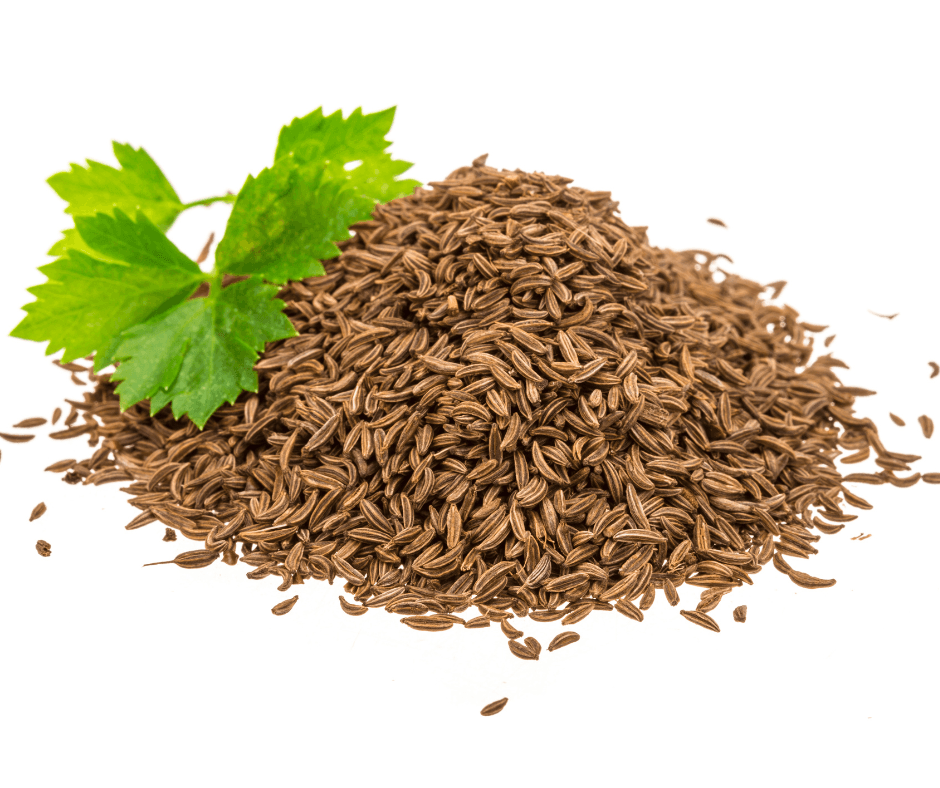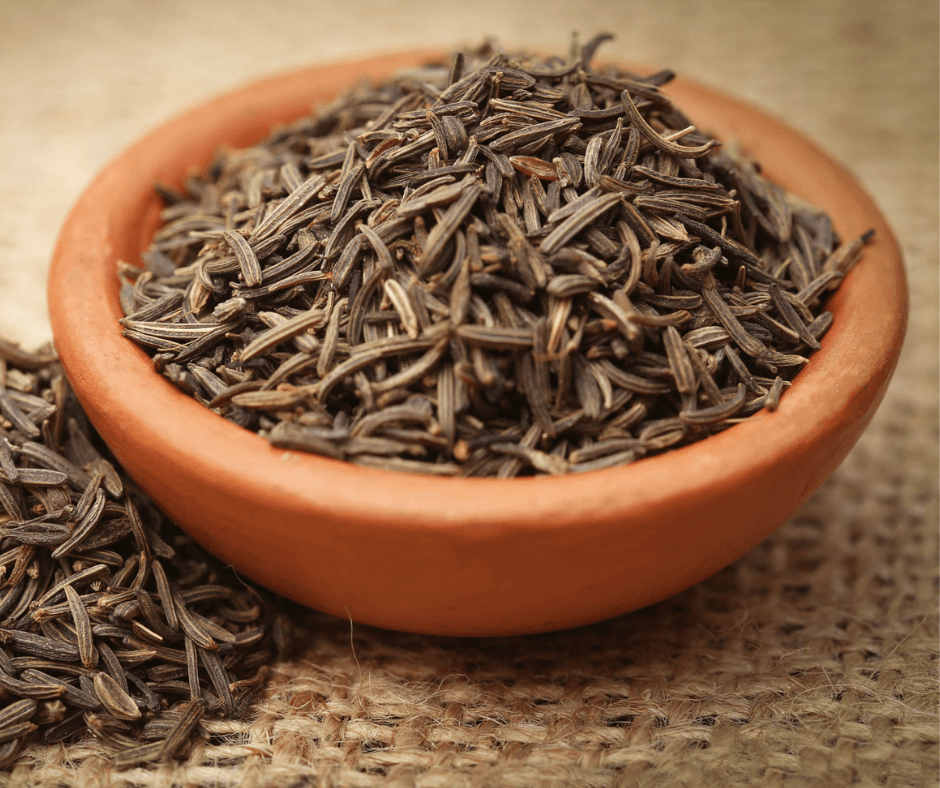Caraway seeds have a rich history and offer both flavor and health benefits. These small seeds are powerful in cooking and medicine. They have a warm, sweet, and slightly peppery smell. This aroma is found in many dishes in Europe and the Mediterranean.
The taste of caraway spice is unique. Its crescent-shaped seeds are dark brown with stripes. They are picked early in the morning to keep their flavor and aroma strong.
Caraway seeds have been valued for centuries for their health benefits. Studies have shown they can help with cholesterol and heart health. This is especially true for the alkaloids in caraway seed extracts.
Caraway seeds are used in many European dishes. They flavor Polish sausages and British cheddar cheese. They’re also in bread, pastries, and liqueurs. Caraway water is used to ease indigestion and flatulence.
Exploring caraway can show you its kitchen uses and health benefits. Sprinkle it on salads or brew it into tea. Caraway seeds add flavor and might improve your health.
What Are Caraway Seeds?
Caraway seeds come from the Carum carvi plant, a biennial herb found in Europe, Asia, and North Africa. They’ve been loved for centuries in cooking, adding a special flavor to many dishes.
Description and Origin
These seeds have a unique taste, like licorice with hints of citrus and pepper. They’re great for adding flavor without taking over. Their taste is often described as a mix of anise, dill, and fennel.

Culinary Use
In European cooking, caraway seeds are a key ingredient. They’re used in:
- Rye bread (especially popular in the U.S.)
- Sauerkraut and other pickled vegetables
- Stews and casseroles
- Desserts and baked goods
- Liquors like Aquavit
They’re a must-have in German, Hungarian, and Polish cooking. They go well with veggies and meats, adding warmth and depth.
Nutritional Profile
Caraway seeds are not just tasty; they’re also nutritious. Here’s what you get in a tablespoon (6.7 grams) of them:
| Nutrient | Amount |
|---|---|
| Calories | 22 |
| Protein | 1.3g |
| Fat | 0.9g |
| Carbs | 3.34g |
| Fiber | 2.6g |
They’re full of important minerals like iron, magnesium, and zinc. They also have antioxidants like limonene and carvone, which could be good for your health.
Health Benefits of Caraway Seeds
Caraway seeds are tiny but mighty when it comes to health. They support digestion, offer antioxidants, and have antimicrobial effects. These benefits can improve your overall well-being.
Digestive Health Benefits
Caraway seeds are great for your digestive health. They may reduce inflammation, especially in conditions like inflammatory bowel disease. If you have indigestion, gas, or bloating, caraway could help.
A study on mice showed caraway’s anti-inflammatory effects in digestive issues. This is promising for humans too.
Antioxidant Properties
Caraway seeds are full of antioxidants. They contain lutein and zeaxanthin, which fight free radicals. Eating these regularly may lower your risk of heart disease and high blood pressure.

Potential Antimicrobial Effects
Caraway seeds also have antimicrobial properties. They can fight off harmful gut bacteria while keeping the good ones. This balance is key for a healthy gut and immune system.
| Benefit | Description |
|---|---|
| Digestive Health | Reduces inflammation, relieves indigestion and bloating |
| Antioxidant Properties | Contains lutein and zeaxanthin, lowers risk of heart disease |
| Antimicrobial Effects | Fights harmful bacteria, maintains gut balance |
| Weight Management | May support weight loss and improve body composition |
Adding caraway seeds to your diet could bring these health benefits. But, always talk to a healthcare professional before making big changes to your diet.
How to Incorporate Caraway Seeds in Your Diet
Caraway seeds bring a unique taste to many dishes. They are becoming more popular in American kitchens. More caraway recipes are being made. Let’s look at some tasty ways to use caraway in cooking.
Caraway-Infused Dishes
Caraway seeds add a rich flavor to savory dishes. Sprinkle them on roasted vegetables or in stews. They also enhance homemade sauerkraut or coleslaw.
These seeds go well with pork, duck, and soft cheeses. They are great for many caraway culinary uses.
Baking with Caraway Seeds
Caraway is amazing in baked goods. It’s essential for classic rye bread. Try adding them to dinner rolls, muffins, or crackers.
For a sweet surprise, make caraway cookies. They are surprisingly tasty!
Tea and Infusions
Caraway tea is calming and might help with digestion. Just steep a teaspoon of seeds in hot water for 5-10 minutes. You can also make a flavorful caraway-infused oil for cooking or salad dressings.
| Dish Type | Caraway Amount | Prep Time |
|---|---|---|
| Rye Bread | 1 tablespoon | 3 hours |
| Roasted Vegetables | 1 teaspoon | 30 minutes |
| Caraway Tea | 1 teaspoon | 5 minutes |
Adding caraway seeds to your cooking opens up a world of flavors. It might also offer health benefits. Start using these versatile seeds in your kitchen today!
Cultural Significance of Caraway Seeds
Caraway seeds have a long history, dating back thousands of years. They were important in ancient cultures. Swiss lake dwellings show caraway’s history goes back at least 5,000 years, starting in the Mediterranean.
Historical Uses in Different Cultures
The ancient Greeks and Romans used caraway for health reasons. They believed it helped with digestion and eased colic. As the Middle Ages came, caraway spread across Europe, from Sicily to Scandinavia. The Romans helped spread it during their conquests.
In Europe, caraway traditions grew. It became a favorite in breads, cakes, and spirits. By the 18th century, a German cookbook listed caraway in 35 recipes, showing its value in cooking.
Folk Remedies and Traditions
Caraway seeds have been used in folk medicine for a long time. People used it to soothe the stomach and treat gas. It was also believed to help with menstrual issues.
Today, caraway is still important in many dishes. It’s used in German sauerkraut, Hungarian goulash, and Indian curries. It’s also a key ingredient in Scandinavian aquavit and kummel liqueur, showing its lasting importance.
| Region | Caraway Uses |
|---|---|
| Ancient Mediterranean | Medicinal: digestion, colic relief |
| Medieval Europe | Culinary: breads, cakes, liqueurs |
| Modern Scandinavia | Beverage: key ingredient in aquavit |
| Eastern Europe | Cuisine: sauerkraut, goulash |
| India | Spice: curries, chutneys |
Caraway Seeds vs. Other Spice Seeds
Caraway seeds are special among spice seeds, offering unique tastes and benefits. When we compare caraway to other spices like cumin and anise, we see its unique traits. Let’s dive into how caraway compares to these popular alternatives.
Caraway vs. Cumin
Caraway and cumin both belong to the Apiaceae family. But they taste and look very different. Caraway seeds are crescent-shaped and dark brown with stripes. They have a sweet, earthy flavor with hints of lemon and anise.
Cumin seeds are larger and lighter brown, shaped like an oblong. They have a smoky, earthy taste.
Caraway is a favorite in European cooking, especially in German, Scandinavian, and Hungarian dishes. It’s great for rye bread, sauerkraut, and root vegetables. Cumin, on the other hand, is loved in Middle Eastern stews, Mexican salsas, and Indian curries.
Caraway vs. Anise
Caraway and anise both have a licorice-like flavor. But caraway tastes milder than anise’s strong, sweet taste. Caraway seeds are often used in savory dishes, while anise is used in both sweet and savory recipes.
| Characteristic | Caraway | Cumin | Anise |
|---|---|---|---|
| Flavor | Sweet, earthy, hints of lemon and anise | Smoky, earthy | Sweet, strong licorice |
| Shape | Crescent-shaped | Oblong | Star-shaped |
| Color | Dark brown | Light brown | Reddish-brown |
| Common Uses | Rye bread, sauerkraut, root vegetables | Stews, salsas, curries | Baked goods, liquors, candies |
Knowing the differences between these spices helps you pick the right flavor for your dishes. Whether you’re looking for caraway alternatives or exploring new flavors, each spice adds its own special touch.
How to Store Caraway Seeds for Freshness
Storing caraway seeds right is key to keeping their taste and strength. If stored well, these seeds can stay fresh for three to four years. Here’s how to keep your caraway seeds tasting great.
Ideal Storage Conditions
For long-lasting caraway seeds, use airtight containers with tight lids. Keep these containers in a cool, dark spot, away from sunlight. This keeps the seeds’ flavor and aroma strong.
Shelf Life of Caraway Seeds
Whole caraway seeds can last up to four years if stored right. Ground caraway, however, lasts about six months to a year. Freezing caraway seeds can help them last even longer.
It’s important to check your seeds regularly. Fresh caraway seeds should smell strong and distinct. If the smell is weak or stale, the seeds are losing their flavor. Always check the taste and smell before using.
| Storage Method | Shelf Life |
|---|---|
| Airtight container in cool, dark place | 3-4 years |
| Ground caraway | 6 months – 1 year |
| Freezer storage | Extended preservation |
By following these tips, your caraway seeds will stay fresh and flavorful. Remember, the right storage is crucial for keeping caraway’s special taste and smell.
Caraway Seeds in Herbal Medicine
Caraway seeds have been used in herbal medicine for over 5,000 years. They are full of essential oils, fatty acids, and other good stuff. This makes them useful in both old and new remedies.
Traditional Remedies
In traditional medicine, caraway seeds help with digestion problems. A common caraway remedy is making tea from crushed seeds. It helps with gas, bloating, and stomach pain. The oil from the seeds is also used in medicine.
Modern Uses
Today, scientists are looking into new ways caraway seeds can help. They think caraway might help with stomach problems and even diabetes. This is because it could lower blood sugar.
Caraway oil is getting attention in aromatherapy. It has carvone and limonene, which are good for health. Caraway seeds are also used to help digestion in pets, showing they’re good for both humans and animals.
| Component | Percentage |
|---|---|
| Essential Oil | 3-7% |
| Fatty Acids | 10-18% |
| Protein | 20% |
| Carbohydrates | 15% |
As research goes on, we might find more ways caraway seeds can help. Always talk to a doctor before trying new herbal remedies.
Potential Side Effects of Caraway Seeds
Caraway seeds are usually safe for most people. But, it’s good to know about possible side effects. This knowledge helps you use caraway safely and well.
Possible Allergic Reactions
Some people might have caraway allergies. Symptoms can vary from mild to severe. They might include:
- Skin rashes or hives
- Itching or swelling of the mouth, throat, or face
- Difficulty breathing
- Nausea or vomiting
If you get any of these symptoms after eating caraway, stop right away. Then, talk to a healthcare professional.
Dosage Considerations
It’s important to know the right amount of caraway to eat. There’s no one-size-fits-all dose. Start with a small amount and slowly add more if needed. Here’s a basic guide:
| Form | Recommended Dosage |
|---|---|
| Whole seeds | 1-2 teaspoons daily |
| Caraway tea | 1 cup, 2-3 times daily |
| Caraway oil | 1-2 drops, diluted in carrier oil |
Using too much caraway oil can irritate your skin. Women who are pregnant or breastfeeding should talk to their doctor before taking caraway supplements. There’s not enough research on its safety for them.
If you have liver or gallbladder problems, talk to a doctor before using caraway. It might affect your gallbladder. Always start with a small amount to see how your body reacts. Then, adjust as needed.
Growing Your Own Caraway
Caraway cultivation is a rewarding hobby for herb lovers. This biennial plant adds unique flavors to your cooking. Growing caraway is easy, making it great for both new and seasoned gardeners.
Ideal Growing Conditions
Caraway loves cool, temperate zones with well-drained soil. Here’s how to grow it best:
- Soil pH: 6.0 to 7.5
- Sunlight: Full sun to partial shade
- Spacing: 30 cm apart
- Depth: Sow seeds 1/2-inch deep
- Temperature: Minimum 4°C for germination
You can start caraway seeds indoors or directly in the garden from April. Plant a second crop a year after the first for continuous harvest.
Harvesting Techniques
Caraway seeds are ready in the plant’s second year. Here’s what you need to know:
- Harvest when seeds turn deep brown
- Cut flower heads and hang to dry
- Shake seeds from dried heads
- Store in airtight containers
Timing is key for the best flavor and oil content. With proper care, your caraway seeds can last up to four years.
| Year | Plant Height | Action |
|---|---|---|
| First | 30 inches (75 cm) | Prune in autumn |
| Second | 90 inches (225 cm) | Harvest seeds |
By following these tips, you’ll have a rich caraway harvest. This hardy plant is easy to care for, making it a great addition to your garden.
Caraway Seed Oils and Extracts
Caraway oil and extracts are becoming more popular. They come from the aromatic caraway seeds. These products are used in cooking and for health benefits.
Uses in Aromatherapy
Caraway aromatherapy is growing in popularity. It has a calming effect. The oil works well with other essential oils, making scents for relaxation.
- Lemon
- Sweet orange
- Ginger
- Cinnamon
- Peppermint
- Lavender
These oils add to the caraway scent. This makes it a favorite for those who enjoy aromatherapy.
Benefits of Caraway Oil
Caraway oil has many health benefits. Research supports these benefits. Its main parts, like carvone, help with health.
| Benefit | Description |
|---|---|
| Heart Health | May reduce heart disease risk factors |
| Respiratory Support | Natural expectorant for respiratory issues |
| Urinary Health | Natural diuretic for urination problems |
| Antimicrobial | Treats infections in the body |
Studies show caraway extract helps with digestive issues and weight loss. Mixing caraway oil with peppermint helps with digestion.
Caraway oil and extracts are recognized for their uses and health benefits. They are used in traditional and modern wellness.
Fun Facts About Caraway Seeds
Caraway seeds are full of interesting facts and trivia. Did you know they’ve been in human food for over 8,000 years? The ancient Egyptians loved them for their taste and health benefits.
Unique Characteristics
Caraway “seeds” are actually fruits. They’re used in many foods like breads and pastries. In ancient Rome, people even ate them as a vegetable.
Today, Finland is the biggest producer of caraway seeds. They make up about 28% of the global market as of 2011.
Myths and Misunderstandings
There are many myths about caraway seeds. In the 17th century, people ate sugar-coated seeds to help with digestion. Some thought they could keep away thieves and evil spirits.
While these stories aren’t proven, caraway seed do have real benefits. They’re used in cough medicines and to help breastfeeding mothers produce more milk.
Caraway seed are also used to attract garden pests and in cosmetics. Whether you love cooking or just learning fun facts, caraway seeds are fascinating.
FAQ
What are caraway seeds and how are they used in cooking?
Caraway seed come from the caraway plant. They taste like licorice, coriander, anise, and fennel. You can add them to many dishes, like rye bread, muffins, and curries.
They’re also good for roasted veggies or pickled foods.
What are the health benefits of caraway seeds?
Caraway seed are full of nutrients like iron and calcium. They have antioxidants and can help with digestion and weight loss. They might also ease indigestion and bloating.
How do you store caraway seeds to maintain their freshness?
Keep caraway seed in an airtight container in a cool, dry place. This way, whole seeds can last 3-4 years. Ground caraway lasts about 6 months to a year.
How does caraway compare to other spice seeds like cumin and anise?
Caraway tastes like licorice, unlike cumin’s earthy flavor. Anise seeds are stronger. Each spice has its own taste and health benefits.
Are there any side effects or precautions to consider when using caraway?
Caraway is usually safe but can cause allergies. It might irritate skin if used too much. It’s not safe for kids or pregnant women. People with liver issues should talk to a doctor before using caraway.
Can you grow your own caraway plants?
Yes, you can grow caraway. It likes cool weather and well-drained soil. Sow seeds in spring and harvest the seeds in late summer of the second year.
What is caraway seed oil used for?
Caraway seed oil is used in aromatherapy. It has calming and digestive benefits. It might also help with infections and breathing issues.
What is the nutritional profile of caraway seeds?
Caraway seed are packed with nutrients. One tablespoon has 22 calories and 2.6 grams of fiber. They’re also full of vitamins and minerals.
How has caraway been used traditionally in different cultures?
Caraway has been used for centuries for digestion. It’s common in European, Middle Eastern, and North African cooking. It’s also believed to ward off evil and was used in love potions.
Can caraway seeds be used to make tea?
Yes, you can make a soothing tea with caraway seed. It’s good for digestion. It’s a tasty way to enjoy caraway’s health benefits.

